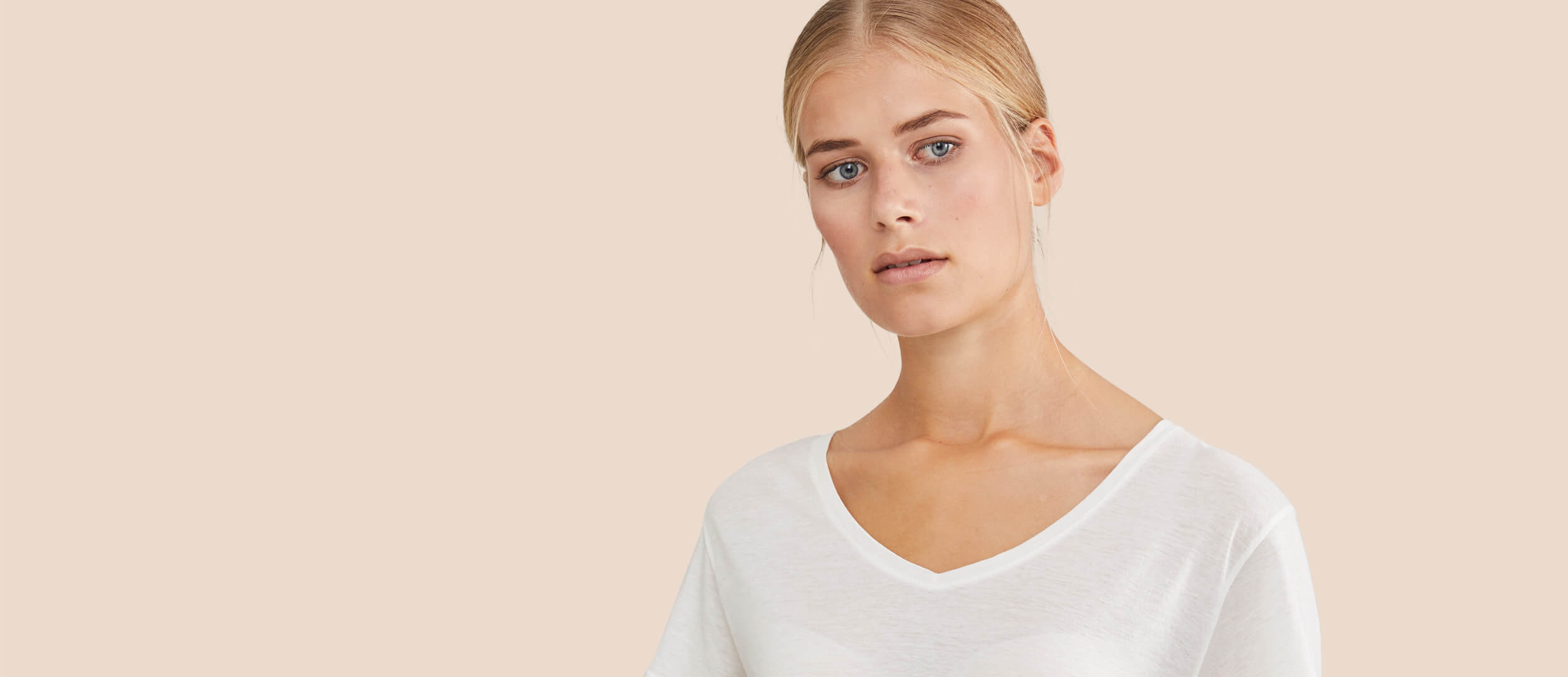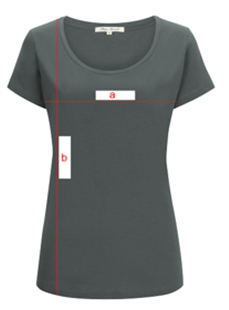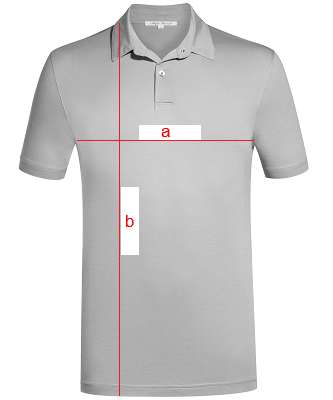LADIES
| Size | XXS | XS | S | M | L | XL | 2XL | 3XL |
|---|---|---|---|---|---|---|---|---|
| Clothing size | 32 | 34 | 36 | 38 | 40 | 42 | 44 | 46 |
| Bust measurement (cm) | 40 | 42,5 | 45 | 47,5 | 50 | 52,5 | 55 | 57.5 |
| Body length (cm) | 59 | 59 | 61 | 61 | 63 | 63 | 64 | 64 |
"Regular Fit": The measurements given in the table apply to the vast majority of women's styles.
Our "Comfort Fit" is cut 3-12 cm wider and applies to the following styles:
"Comfort Fit / Plus 3 cm": SIENNA, SIENNA LA, MILLA P, CIARA, ALESSA LA, MAILA, MAILA LA, FEDRA, FRITZI, FAUN, FRIEDE
"Comfort Fit / Plus 6 cm": FABIA, FABIOLA, FELIPA, FABIENNE
"Comfort Fit / Plus 10-12 cm": POLA LA, FEBE LA
a: Chest measurement: Measure under the armpits at the point of the largest chest measurement.
b: Body length: Measure left from the collar welt to the lower edge of the hem.
MEN
| Size | XS | S | M | L | XL | 2XL | 3XL | 4XL |
|---|---|---|---|---|---|---|---|---|
| Clothing size | 44 | 46 | 48 | 50 | 52 | 54 | 56 | 58 |
| Bust measurement (cm) | 45.5 | 48 | 50.5 | 53 | 55.5 | 58 | 60.5 | 63 |
| Body length (cm) | 68 | 69 | 71 | 72 | 74 | 75 | 76 | 77 |
a: Chest measurement: Measure under the armpits at the point of the largest chest measurement.
b: Body length: Measure left from the collar welt to the lower edge of the hem.
- Belgium
- Bulgaria
- Denmark
- Estonia
- Finland
- France
- Ireland
- Italy
- Croatia
- Latvia
- Lithuania
- Luxembourg
- Malta
- Netherlands
- Austria
- Poland
- Romania
- Switzerland
- Slovakia
- Slovenia
- Spain
- Czech republic
- Hungary
- Great Britain
- Cyprus
- Greece
- Portugal
- Sweden
- Spain
The combination of dyes and substances of the highest quality* with a 15-stage in-house prefit treatment guarantees a human-ecologically optimized knitted fabric and a number of truly unique features. In the process with water, steam and heat, in a (quasi-) closed system at approx. 130°C, excess pigments and other pollutions are removed from the fabric (without chemical additives). The fabric remains fresh even after prolonged wear and perspiration because the transfer of substances from the fabric to the skin or a decomposition reaction with body perspiration is prevented. The products are therefore ideal for people with sensitive skin or allergy sufferers.
The process includes complex manual techniques, which are also a novelty. The usual industrial machine processes, which mechanically stress the knitted fabric, are replaced by manual gentle processes. The result is an exceptional inherent elasticity and dimensional stability of the fabric, maximum color fastness and suitability for dryng /dryer for all our products.
In the final stages of this innovative process route, the "South American silk" inherent in the superfine cotton is finally brought out. This explains the unique feel and look of the finest Urpima®️ jersey fabrics. Urpima®️ is a registered trademark of Stefan Brandt.
*The dyes and auxiliaries used are GOTS (Global Organic Textile Standard) certified and listed in the bluesign®bluefinder for sustainable textile production and also support the ECO-TEX®Standard 100, Cradle to Cradle®(EPEA) and the EU Ecolabel.
Urpima©️ is a brand of Stefan Brandt and stands for selected bales of Peruvian ELS (extra long staple) Pima cotton, where unripe and overripe fibres are not picked (selected bales) and in an innovative process route, in combination with the revolutionary 15-step prefit treatment, the "South American silk" inherent in this luxury cotton is gradually brought out.
Stefan Brandt's style is a tribute to the materials used and the precision craftsmanship in the production. This is also reflected in the use of elaborate hand-stitching techniques. For collars, cuffs and button bands, all fabric and fusion interlinings are fixed by hand stitch with needle and thread before sewing. In the jersey segment, this application is an innovation and at the same time a guarantee for precise fits.
The seamstresses also check the measurements "in-situ", i.e. continuously during the sewing process, thus guaranteeing a fit accuracy of +- 1mm.
Seams that require exact symmetry are sewn with templates. Our (mother-of-pearl) buttons are sewn on by hand "on the stem" and crosswise. The sewing of the button in a single - visually hardly noticeable - point has been the usual standard at Stefan Brandt since day 1, but is unique, probably worldwide. The button cannot tear off even under high tensile force (rather the knitted fabric breaks). A replacement button is therefore not necessary. The above-mentioned and numerous other ready-made elements, which conventional industries implement with automatic machines, are consistently sewn by hand at Stefan Brandt. Because there is no "shortcut" to excellence.
Stefan Brandt's knitted fabrics are exceptionally inherently elastic and dimensionally stable. The reason for this is primarily Stefan Brandt's innovative in-house prefit treatment; and here above all that mechanical tensile and compressive stresses on the knitted fabric are kept below a threshold value throughout the entire process. This is achieved with gentle manual processes that minimise the formation of (initially microscopic) stress matrices in the knitted fabric and thus significantly increase the macroscopic elasticity limit and dimensional stability.
Stefan Brandt considers mechanical processes, including the typical rolling of the knitted fabric webs or the stretching of the fabrics to uniform and large widths before cutting, to be no-goes, even though they seem to be the rule worldwide without exception.
Local tension matrices, i.e. damage to the knitted fabric, can be largely avoided and the elastic limit significantly increased with the help of manual techniques. These manual techniques are associated with high costs, but explain the uniqueness of the fabric in terms of ELASTICITY and SHAPE STABILITY. The manual processes are time-consuming and associated with high costs (material waste, loss of production capacity, etc.), but are the guarantee that the fabric does not lose its shape and has the high inherent elasticity, even without elastane. The raw knitted fabrics also go through a PREFIT TREATMENT with water, steam and heat, without chemical additives, in which machine processes are also largely replaced by manual ones and provide further individual characteristics.
The difference between the fabric types is that the items with Anexo 50 are slightly lighter (125g/m²) and even silkier, which also results in a higher light reflection. Men's T-shirts in this 50 fabric are slim fit.
The pieces with Anexo 30, on the other hand, are slightly heavier (175g/m²) but equally popular with our customers.
Some love the extremely silky and bright look of 50s shirts, others prefer a slightly thicker (but still very silky) fabric and opt for 30s.
Colour fastness is the resistance of dyeings to various effects, especially washing. Stefan Brandt works exclusively with dyes and auxiliaries of the highest grade available worldwide.*
However, the real success is achieved by the additional in-house Prefit treatment. In this process, with water, steam and heat, without chemical additives, even the last "loose pigments and impurities" are dissolved out of the fabrics. Even after prolonged wearing and sweating, the fabric still feels fresh, as there are no more harmful substances in the knitted fabric that could transfer to the skin or enter into a decomposition reaction with body perspiration. The combination of high-quality ingredients with the elaborate Prefit treatment produces a precious knitted fabric that, according to current findings, is particularly suitable for people with sensitive skin or allergy sufferers.
*The dyes and auxiliaries used are GOTS (Global Organic Textile Standard) certified and listed in the bluesign®bluefinder for sustainable textile manufacturing and also support the OEKO-TEX®Standard 100, Cradle-toCradle®(EPEA) and the EU Ecolabel.
Pima cotton is classified as a luxury fibre because of its fibre fineness.
Prized for its exceptional softness and natural silky sheen, it is also known as the silk of South America. Peruvian Pima cotton is the finest of the Pima cotton varieties and grows in the northern coastal valleys of Peru. There, the rich soils soak up the ideal amount of moisture at almost perfect equatorial temperatures. The result is a cotton with particularly long fibre lengths (30-35 mm). Unlike many of the commercial cottons, Peruvian Pima cotton is still harvested entirely by hand to avoid damage to the fibre that occurs during machine harvesting. Industrial harvesting leaves scratchy impurities that affect the smoothness of the cotton and cause an unsightly yellow tinge. In comparison, the result of hand harvesting is a glossy shade of white that is ideal for dyeing. Hand harvesting is also more environmentally friendly.
The top priority for Stefan Brandt is that the fabric does not lose its shape.
An innovative process route of Stefan Brandt's guarantees that the mechanical stresses on the knitted fabric remain below the threshold value of the deformation limit. This successfully suppresses microscopic deformations, which macroscopically manifest themselves in a reduction of the dimensional stability, or prevents permanent damage due to local overstretching.
This manual gentle process delivers impressive material characteristics. The inherent elasticity is so exorbitantly high that textile experts often assume that it is due to an elastane content in the knitted fabric; in fact, however, it is the natural inherent elasticity due to the special in-house techniques. The wearing comfort is impressive and the fabric retains its shape even after washing.
Stefan Brandt products are tumble dryable, whether they are Pima cotton, linen, silk, wool or exclusive blends of silk, wool, cashmere, viscose and modal. Each of our qualities has real unique selling points, i.e. properties that are unique in the world. One of these is our universal drying properties as a result of our prefit treatment.














